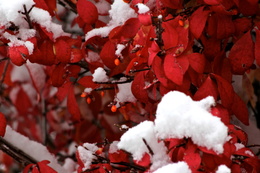A burning bush shrub is just what you need to fill your garden with vibrant color. Read this article to know more about this plant.

One of the best sights to behold is a well-kept garden. A garden that has been nurtured with love and care is very recognizable. And it stays in the memories of everyone who sees it. If you are a fan of gardening and wish to have a stunning garden that will remain in everyone's mind even long after they've seen it, then a burning bush shrub is what you need to add to it. What is a burning bush? Why is it called so? Read the information below to find out more about this wonderful plant. You'll definitely want one in your garden too.
The Burning Bush Shrub
Scientifically, the burning bush shrub is called
Euonymus alata. This name has been derived from the Latin word
alata which means 'with wings'. This name is attributed to this plant owing to its 'winged' appearance when it is in full bloom. This landscaping shrub is deciduous in nature. It has branches, which resemble corks, sticking out of its trunk. This is why it has a winged look about itself. Throughout the year, it has this cork-like foliage, but when autumn comes, its foliage develops shades of red, varying from light pink to bright red. The entire bush is filled with vividly colored leaves, which give it an appearance of being on fire. Hence it is called the 'burning' bush. This bush, with its flaming red foliage serves as an excellent hedge plant. It also helps to brighten up a landscape. You can either plant just a single bush in a background of green or have a lot of them planted altogether for a bright and fiery appearance.
Caring for It
Of all the shrubs and bushes that you can use for landscaping, this one is probably the easiest to grow and maintain. There are some who believe that these plants are 'aliens' in North America, because they are originally native to Asia. Given below are some of the most important care tips for this hot red bush.
- Climate: They survive well in Zone 4 to Zone 8 climate, according to the USDA. This means all areas that have temperatures between -30º F to 20º F are suitable for this plant to grow.
- Soil: Soil-wise, this is a very adaptive plant. It requires well-drained soil to grow properly. So make sure that the soil that you plant it in is moist, but that it does not retain the water for too long. It can grow well in acidic or alkaline soils, which range from fertile, clay to sandy or even rocky.
- Sun: The burning bush shrub absolutely loves the sun. So, if you're thinking of planting it in your garden, pick a spot that receives a lot of sunlight. It can grow well in partial sun too, but the more the sunlight, the better the foliage color.
- Pruning: The average size of this plant, if allowed to grow without pruning, is somewhere around 15-16 feet in width and around 12-13 feet in height. But you need to carry out regular pruning to enjoy its foliage color at ground level. For this, you need to judge for yourself which shape will look better in your garden. It looks best in its original round shape. So, if you're wondering how to prune it, cut out the dead branches and leaves with a pair of sharp shears in such a way that this round shape is maintained. Pruning this shrub, like any other shrub or bush, is an essential step to keep it from growing too tall and awry.
- Problems: One of the most common problems with this plant is an insect known as scale. This insect is found in its bark. It infects the bark and hampers the healthy growth of the bush. Also, excessive mulching can deprive the plant of its nitrogen content. As a result, the plant may turn a light shade of green before fall. Do not confuse this with its fall foliage, because it is the plant's way of telling you that something is amiss. So, remove the mulch, add fertilizer to the roots, water the plant, and then re-mulch it in moderation.
The burning bush shrub is one of the most gorgeous shrubs that will enhance your landscape and give it a festive look. Don't forget to click photographs of this stunning shrub in fall!






 One of the best sights to behold is a well-kept garden. A garden that has been nurtured with love and care is very recognizable. And it stays in the memories of everyone who sees it. If you are a fan of gardening and wish to have a stunning garden that will remain in everyone's mind even long after they've seen it, then a burning bush shrub is what you need to add to it. What is a burning bush? Why is it called so? Read the information below to find out more about this wonderful plant. You'll definitely want one in your garden too.
One of the best sights to behold is a well-kept garden. A garden that has been nurtured with love and care is very recognizable. And it stays in the memories of everyone who sees it. If you are a fan of gardening and wish to have a stunning garden that will remain in everyone's mind even long after they've seen it, then a burning bush shrub is what you need to add to it. What is a burning bush? Why is it called so? Read the information below to find out more about this wonderful plant. You'll definitely want one in your garden too.